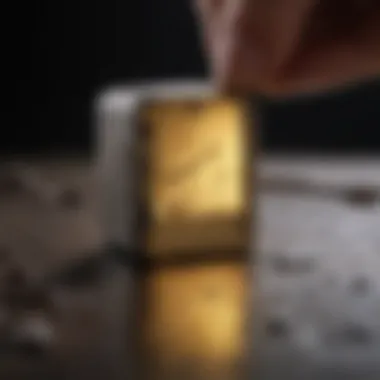Essential Techniques to Identify Authentic Gold


Intro
Gold has always shimmered in human history, its allure transcending time and cultures. From ancient civilizations that used gold for ornaments and coinage to modern-day investors seeking value, the quest to distinguish real gold from the pretenders is as old as gold itself. This guide sets out to provide collectors and enthusiasts alike with the means to navigate this sometimes murky waters. Recognizing the unique traits that define genuine gold and utilizing effective identification techniques can empower individuals to make informed decisions when confronted with a myriad of imitations in today’s market.
As more counterfeit items surface, understanding gold’s value becomes even more crucial. This article aims to not only educate on how to identify real gold but also on why that knowledge matters. Whether you’re rummaging through estate sales, visiting pawn shops or simply wanting to understand better the precious metal you have, being equipped with the right tools and knowledge is essential.
"In a world filled with copies, knowing what’s authentic is like having a treasure map etched in gold."
Let us dive into the history and origins of gold, explore its significance, and equip ourselves with techniques to recognize its authenticity.
Understanding Gold: A Physical and Chemical Perspective
When it comes to gold, understanding its physical and chemical properties is fundamental for anyone looking to identify authentic pieces. Gold isn’t just a shiny ornament; it's a metal rich in history, value, and complexity. Grasping its composition and characteristics plays a crucial role in distinguishing real gold from counterfeits. This section aims to lay down the groundwork necessary for enthusiasts, collectors, or even everyday consumers to appreciate what makes gold genuine and treasured.
The Composition of Gold
Gold is an element, represented by the symbol Au on the periodic table. It has unique atomic characteristics, specifically with an atomic number of 79. This gives it inherent qualities, such as resistance to oxidation and corrosion. As a result, gold doesn't tarnish like other metals. This durability is part of what drives its appeal, not just in jewelry but also in industrial applications, electronics, and even medicine. Understanding its elemental makeup can aid in recognizing its real form, ensuring one doesn't fall victim to clever imitations.
Properties That Distinguish Gold
Color and Luster
One of the most eye-catching features of gold is its distinctive color and luster. Real gold presents a rich, warm yellow hue. This radiance is due to how it reflects light, giving it a lavish appearance. Unlike many impostors that may appear shiny but rather dull or greyish under certain lighting, real gold maintains its vividness and shiny surface. This natural glow invites admiration while also serving as a basic identifier in preliminary evaluations. It’s no wonder that this quality has made gold a popular choice for ornaments throughout history.
Weight and Density
Weight and density are critical characteristics when identifying gold. Gold is surprisingly heavy for its size. To illustrate, if you compare a piece of gold the size of a dime to a similarly sized item made from a different metal, the gold will feel denser and heavier. The actual density of gold is approximately 19.32 grams per cubic centimeter. This is key not just in ensuring authenticity but also in gauging the value of the item at hand, reinforcing why understanding these qualities is indispensable.
Malleability and Ductility
Gold's malleability and ductility contribute significantly to its allure. Not only can gold be hammered into thin sheets (as thin as 0.0001 inches), but it can also be drawn into wires. This versatility allows artisans to create intricate designs that would be impossible with many other metals. It is the softness of gold that lends itself to a myriad of applications, but it’s important to know that not all gold items are purely gold—as it can easily blend with other metals, which can affect these properties.
Gold Alloys: Understanding Purity
Karat System
The karat system is prevalent in determining the purity of gold. Pure gold is described as 24 karats, but most jewelry is not solid gold; instead, it is mixed with other metals to increase durability. For example, 18-karat gold contains 75% gold and 25% other metals, which can help alter its color and resilience. Understanding the karat system will give you insight into the value and quality of your gold pieces. The lower the karat, the less gold present, which relates directly to authenticity and price.
Role of Other Metals
When discussing gold alloys, it’s important to recognize the role played by other metals. Metals such as copper, silver, or palladium are often added to gold to improve its strength and alter its appearance. For instance, adding copper creates a reddish hue often referred to as rose gold. While these additions enhance certain traits of the gold, they can also impact the overall value and quality. Knowing the composition of your gold item becomes vital for confirming its authenticity.
The purity of gold is not just a number in karats; it reflects the inherent value of the piece and its significance in your collection.


The Marketplace: Recognizing Risks and Assessing Authenticity
Navigating the gold marketplace requires a keen eye and a solid understanding of what to look for. There's a world full of treasures out there, but lurking behind the allure of shiny trinkets can be a multitude of risks. Knowing how to assess authenticity not only protects your investment but also enriches your appreciation for gold itself.
In this segment, we delve into the dynamics of the market and shine a light on some common imitations and counterfeits that one might encounter. Wise collectors and casual buyers alike benefit from being informed about these issues.
Understanding Market Dynamics
The gold market is as dynamic as they come, constantly influenced by global economic shifts, inflation rates, and even geopolitical tensions. The price of gold can fluctuate day to day, making it essential to stay updated. Understanding these trends is not just about keeping track of price tags; it’s about reining in the factors that drive those prices up or down.
For instance, during uncertain economic times, gold often becomes a go-to investment for many, which causes its value to surge. In contrast, a booming economy may push prices downward as investors look to different assets. So, keeping your ear to the ground can provide you with insights into when to buy or sell.
Additionally, it’s crucial to be well-acquainted with reputable dealers and platforms. Jointing reputable groups on platforms like Reddit or engaging in communities on Facebook can steer you to trustworthy information that helps you make educated decisions.
Common Imitations and Counterfeits
The allure of gold has prompted a sea of imitations and counterfeits. While real gold has specific characteristics that stand out, counterfeit products can sometimes fool the untrained eye. It's imperative to know what you're dealing with. Here, we’ll break down some major contenders that often mislead buyers.
Fool's Gold
Fool's gold, or iron pyrite, is renowned for its metallic luster and deceptive golden sheen. It’s often found in proximity to real gold, leading many to mistake it for genuine treasure. The prominent characteristic of fool's gold is its brassy color, which lacks the warmth of real gold. While it can be an exciting find, it lacks any real value, serving as a tantalizing reminder that all that glitters isn’t gold.
In this guide, recognizing fool's gold is beneficial as it highlights the necessity for a discerning eye. It's a common pitfall, particularly when sifting through older collections or natural deposits where the two may be closely found.
Gold-Plated Items
Gold-plated items can be quite shiny and appealing, as they feature a thin layer of gold over a base metal. While this can make them visually similar to solid gold, the key aspect here is the thinness of that gold layer. It’s important to realize that while these items may look valuable, they do not carry the weight or value of pure gold. With wear and tear, the gold plating may eventually wear off, revealing the less glamorous metal beneath.
This type of knowledge is crucial because many sellers might present gold-plated items as solid gold, leading to a steep price paid for an item that is little more than shiny decoration. In terms of investment, collector's interest in gold-plated items is typically low compared to the value of solid pieces.
Other Precious Metal Imitations
When it comes to other precious metal imitations, the landscape widens. Sudden appearances of metals like silver, platinum, and rhodium can catch buyers off guard. These alternatives are often cast or coated to mimic gold in appearance. Some common examples include silver with a gold look and various alloys designed to evoke a golden aesthetic.
Understanding these imposters is essential for any serious collector because they can cloud judgment when assessing value. Each type of metal has its own market and characteristics that differentiate them from real gold. Even though these imitations can be stunning to behold, they simply lack the intrinsic value that comes with gold.
In summary, assessing authenticity in the marketplace connects to a broader understanding of market dynamics and imitation risks. , and this leads to a more informed and secure paying of treasures that one might encounter. Collecting and appreciating valuable items like gold demands vigilance, knowledge, and often a trained eye.
Practical Techniques for Gold Identification
Identifying real gold can be a tricky endeavor, especially with the plethora of fakes and imitations flooding the market. Thus, practical techniques for gold identification become essential tools in a collector's arsenal. These methods not only help ascertain the authenticity of gold but also empower buyers to make informed decisions. Understanding these techniques can save individuals from costly mistakes while fostering a greater appreciation for their gold investments.
The Magnet Test
One of the simplest methods to detect fake gold is the magnet test. This technique relies on the basic principle that gold is not magnetic. When you place a magnet near the item in question, observe closely. If the piece clings to the magnet, it’s a clear indication that it is not real gold.


These tests are quick and non-destructive, making them accessible for almost anyone. Users should keep in mind, however, that some gold alloys might include small amounts of magnetic metals. Thus, while a negative result from the magnet test strongly suggests authenticity, it should not be the sole determining factor for a conclusive decision.
The Scratch Test
The scratch test is another straightforward technique. It involves making a small scratch on an inconspicuous area of the item and then comparing the scratch against a designated gold testing stone. The stone is usually made of a harder material like ceramic, which helps in establishing a clearer distinction.
When you apply the metal to the testing stone, it should leave a distinct trace. This trace can then be tested using acid to identify karat content. Many collectors appreciate the scratch test for its simplicity, though it's important to note that it does leave a mark, so choose wisely where to do it.
Acid Testing Methods
How Acid Testing Works
Acid testing provides one of the most reliable methods for confirming the authenticity of gold. In this process, a small amount of acid is applied to the scratched area of the sample. Each acid concentration corresponds to a specific karat; for instance, a stronger acid would be used for higher purity gold.
The reaction between the acid and the gold will indicate whether the item is legitimate. If the gold dissolves, that signals a lack of authenticity. This method is favored due to its effectiveness and precise results, but it can be somewhat harsh on the item being tested. Given that real gold remains stable against these acids, this method is popular among professionals.
Common Acid Concentrations
Various acid concentrations are typically used, including 10k, 14k, and 18k solutions. Each is tailored for specific assessments, allowing for nuanced testing of varying gold purity levels. It's essential to understand which acid corresponds to which karat.
The uniqueness of this method lies in its specificity. By using the right concentration, collectors can gain deeper insights into their gold's quality. However, the need for careful handling and the risk of damage to the surface is a downside that purchasers must keep in mind.
The Jeweler's Loupe and Other Tools
Using a Loupe
A jeweler's loupe is a critical instrument for any serious gold collector. This magnifying glass allows users to scrutinize the details of gold items closely, from markings to surface texture. With high magnification, one can spot subtle details that are usually invisible to the naked eye.
Though simple in design, the loupe serves a substantial purpose, helping collectors verify maker’s marks or stampings that guarantee quality. However, mastering its use requires practice; familiarity leads to finding those nuanced telling signs.
Other Essential Tools
Beyond the loupe, collectors should consider investing in a few additional items. A scale for weight measurements, a measuring caliper for dimensions, and test stones can provide additional layers of assurance in authenticity. Each tool enhances the know-how of the collector, fostering a hands-on approach to gold evaluation.
All these tools combined can create a harmonious methodology for assessing gold items.
"The right tools can, quite literally, turn an educated guess into an informed decision."
Utilizing a variety of techniques not only increases confidence in one’s gold identification skills but also creates a more enjoyable experience for the collector as they deepen their knowledge.
Professional Assessment and Certification
In the world of gold identification, the importance of professional assessment and certification cannot be overstated. With the market flooded with imitations and counterfeits, turning to experts ensures that one can confidently discern real gold from fakes. This section elucidates why seeking professional certification is pivotal for anyone serious about gold investment or collection.
One of the primary benefits of professional assessments is the assurance they provide. Knowing that an item has been evaluated by a skilled expert adds a layer of prestige and trustworthiness. A reputable professional can spot the subtle characteristics that a layperson might overlook. They possess both knowledge and experience, which brings reliable insights into the assessment process. Moreover, expert evaluations are often adhered to by certification standards that lend credibility to the findings.


Common considerations when engaging a professional for gold assessment include their credentials, experience, and reviews from past clients. It’s crucial to seek experts affiliated with recognized institutions or associations. This affiliation helps ensure they adhere to the established standards of evaluation. You may also want to consider the types of tools the expert uses. The best practices and equipment—like X-ray fluorescence (XRF) analyzers—allow for a more thorough analysis than ordinary methods.
"In gold evaluation, expertise is as essential as the gold itself. The difference can often be found in the minuscule details."
Finding Credible Experts
Finding credible experts can feel like searching for a needle in a haystack. The gold market is vast and can sometimes mask the less reputable figures. One way to locate commendable professionals is through word of mouth; recommendations from friends, family, or fellow collectors can lead you to trustworthy individuals. Additionally, check on online forums such as Reddit, where passionate collectors often discuss their experiences and share valuable insights about expert assessments. Websites like Facebook also host community groups dedicated to collectors where members might refer service providers.
Verification of an expert's credentials is another important step. Look for certifications from recognized organizations—like the Gemological Institute of America (GIA)—that indicate the professional's level of expertise. It might also be sensible to explore their previous work; consider requesting references or examples of past assessments. When possible, visiting the expert in person can also help gauge their professionalism and knowledge.
Understanding Certification Standards
Certification standards serve as a benchmark for assessing the authenticity of gold. These standards vary significantly across different regions and institutions. Understanding the basics of these standards can empower collectors and investors alike. For instance, in many places, a certified piece of gold jewelry will come with a report that details its karat weight and material composition, which is vital for understanding its value.
Moreover, various organizations have developed internationally recognized standards. The World Gold Council, for example, outlines criteria that can aid in the evaluation of gold products. Familiarizing oneself with these criteria can make a significant difference when negotiating value during buying or selling. Facilitating clear communication with potential buyers or sellers is critical, and knowing these standards helps to ensure you're all on the same page.
In summary, involving professional assessors and understanding certification standards can provide a foundation of trust in the complex landscape of gold dealings. The knowledge gained through these processes benefits both new and experienced collectors, safeguarding against the pitfalls of the gold market.
Maintaining and Caring for Gold Items
To many, gold is not just a metal; it’s a cherished possession, often loaded with memories and sentiments. Hence, knowing how to preserve its beauty and value is of utmost importance. Proper maintenance and care can enhance the lifespan of gold items, helping them retain both their aesthetic and monetary value.
Proper Storage Techniques
Storing gold correctly can prevent unnecessary harm and wear. The following approaches ensure that your gold remains in tip-top shape:
- Avoiding contact with other jewelry: When storing gold items, it’s wise to keep them separated to avoid scratches. Using soft pouches or lined containers for each piece can be a game-changer.
- Choosing the right environment: Store gold in a cool, dry place—this helps steer clear of moisture, which can lead to tarnishing or corrosion. A cloth-lined box or a dedicated jewelry case can do wonders.
- Considering humidity levels: High humidity can be the enemy. You might want to include a silica gel packet in your storage area to absorb excess moisture, keeping gold items safe and sound.
Cleaning Gold Safely
Cleaning gold is crucial, but it’s important to do it without damaging it. Here’s a straightforward approach to keep your gold gleaming:
- Mild soapy water method: Mix warm water with a little dish soap. Dip a soft cloth or sponge in the solution, then gently rub your gold items. Rinse thoroughly with clean water and dry them carefully with a lint-free towel. Avoid harsh chemicals, as they can harm the finish.
- Using a soft brush: For intricate designs or settings, a soft toothbrush can help reach those nooks and crannies. Just be gentle, as too much pressure can scratch the surface.
- Regular maintenance: Try to give your gold a gentle clean every few months. Regular upkeep stops dirt and grime from building up, which could dull its shine over time.
Remember, your gold items are an investment. Proper care not only preserves their allure but also keeps them ready to be passed down for generations.
Maintaining and caring for gold isn’t merely about keeping it shiny; it’s about protecting your investment and ensuring that every piece continues to tell its story. With the right techniques, you ensure that your gold remains a gleaming symbol of value and beauty.
End: The Value of Knowledge in Gold Identification
Recognizing real gold is not just a matter of aesthetics or personal preference; it’s an endeavor intertwined with financial prudence and informed choices. In a marketplace bustling with options, the ability to discern genuine gold from its fakes is crucial. It fosters confidence, whether you’re a collector aiming to build a precious inventory or simply someone looking to purchase a piece of jewelry.
Understanding gold’s unique properties—its weight, color, and luster—truly enhances your ability to make sound decisions. Moreover, practical tests like the magnet test or acid testing allow you to verify authenticity on the spot, which is not only empowering but mitigates the risks associated with buying gold.
The repercussions of ignorance in this realm can be significant. Investing in counterfeit items can lead to financial losses, and there’s the emotional toll of discovering a treasured piece is nothing more than a clever imitation. Thus, honing your skills in gold identification has a direct impact on maximizing your investment and ensuring that your collection is both authentic and valuable.
Equally important is the role of experts and certifications, which provide a layer of assurance when purchasing higher-end pieces. As you grow more knowledgeable, you’ll learn to seek out reputable sources and understand the certification process. This, in turn, plays a critical part in protecting your investments.
Recap of Key Points
- Understanding Gold: Knowledge of gold's physical and chemical properties provides foundational insight.
- Market Awareness: Familiarity with common imitations helps you identify potential counterfeits.
- Practical Tests: Techniques like the scratch test and acidity measures serve as immediate verification methods.
- Expert Opinions: Leveraging the insights of certified professionals enhances purchasing confidence.
- Maintenance Awareness: Recognizing how to care for your gold in the long run protects your investments and keeps your items in pristine condition.



